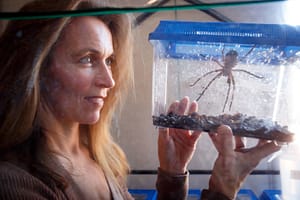Spiders help biology major Samantha Crotty ’22 and mentor understand how brains age
Professor Ruth Fabian-Fine says similarity of their auditory systems to humans' led to her research focus of several years with students

Professor Ruth Fabian-Fine and a spider in her lab in a file photo.
Years before she became a biology and neuroscience professor at Saint Michael’s College, Ruth Fabian-Fine did undergraduate studies at the Johan Wolfgang-Goethe University in Frankfurt, Germany. Her course work including a memorable class about auditory systems in which she dissected the auditory systems of insects, amphibians, birds, and mammals. In her subsequent class she investigated sensory systems in Central American Wandering Spiders (Cupiennius salei) and made striking observations.
“When I saw the [auditory] system of this animal I was dissecting, I thought that it had so many striking similarities to our own human ear. So, I wondered if… [this hypothesis was correct],” she said – and so began a career-focusing interest in spiders and their auditory systems with the goal to utilize them as a model system to investigate cellular aspects of signal processing in sensory neurons.
This summer, Professor Fabian-Fine is the faculty mentor for summer research to rising senior Samantha Crotty ’22. The biology major from Nashua, NH, has spent the summer assisting her mentor and researching another project that is investigated in the spider system and involves the effects of aging on the brain of C. salei.
Initial findings show significant differences in the brains of young and old spiders, Crotty said, explaining, “We are using these spiders specifically because they serve as a great model organism for humans. This means that they provide a lot of insight into the biological functions the human species experiences.”

Samantha Crotty ’22
Fabian-Fine explained in greater detail: “I believe that the spider system is very similar to the mammalian system because we are the descendants of them on the phylogenetic tree [otherwise known as the evolutionary tree]. This tree is a branching diagram showing the evolutionary relationships among various biological species and other entities based upon similarities and differences in their physical or genetic characteristics,” she said. “There are many species that are studied as model systems like the Drosophila flies [the fruit fly]. It turns out that they have a lot of similarities with higher developed organisms in particular signaling pathways and gene expression patterns.”
Crotty said she and Fabian-Fine hope results from their work and similar studies will help to gain a better understanding of aging processes in neuronal tissue of the brain, “especially in illnesses that we still have a lot to learn about, like dementia and Alzheimer’s disease. We are hoping that this research will contribute to a better understanding of aging processes that take place in the nervous tissue of this spider.”
The group’s primary goal it to learn more about what happens to the brain as it ages. “It is striking what happens to the brain as it ages, specifically in the spiders,” said Fabian-Fine. “As the spider ages, the older animals have so much electron-dense plaque. It accumulates over the life of the animals, and it actually changes the cell structure. The nervous system does not look as healthy compared to the young animals.”
“Describing where this plaque is deposited from within the cell, and what the likely metabolic pathway for this plaque is, can tell the metabolic end products from activities throughout the day,” she said. For all the non-scientific folks who are wondering what this could possibly mean, Fabian-Fine described these “end-products” as needing to be placed somewhere. There are some cells that are basically the “garbage trucks” and they incorporate the end-products to break them down and either recycle them or remove them from the brain.
“We are seeing that it works fairly well in the young animals, but in the older animals, it doesn’t work so well anymore,” she said. As the spiders grow older, the plaque accumulates in the central nervous system. “We are describing how does it look in the old vs young animal and then the second part is trying to identify this plaque. What kinds of proteins, or molecules, accumulate? Is there a way we can get rid of that plaque in older animals? Are there enzymatic functions that we can regulate in order to get rid of it or is there something to avoid regarding the nutrition or activity of the animals that will reduce the plaque that accumulates as they get older?”

A slide image from a microscope illustrates what happens in spider brains as Professor Fabian-Fine describes.
The professor stated that humans are living longer and dying later because of the medical advances of our present day. Our technological advances impact the way we treat individuals. So, the goal of her research with students on spiders is to find answers to the posed questions and advance our understanding of aging processes.
“It looks as if the integrity of the cells, whether they are intact or broken down with age, suffers from all of these plaque deposits within them,” said Fabian-Fine. “When we dissect the brains, the older brains literally drip because the cells are not intact. We see this at the microscopic level, and the cells no longer have the integrity that the younger brains have.”
Because of the similarities of how neurons in invertebrates and vertebrates function, these studies are relevant to the general understanding of aging processes. “The accumulation of cellular debris within the cells of the brain is the most interesting finding so far,” said Crotty. In the end, the group hopes to eventually publish their findings.





